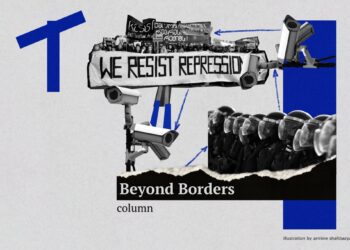
Listen to the article.
Next year, Armenia will hold its third parliamentary elections. Experts have raised concerns about the controversial “stable majority” provision in the Constitution—a measure that distorts proportional representation and undermines parliamentary rule.
The country transitioned from a semi-presidential to a parliamentary form of government through a controversial constitutional referendum in 2015 that brought in sweeping changes. These amendments took effect in 2018, when Serzh Sargsyan’s second presidential term ended.
Many viewed the 2015 constitutional reforms as Sargsyan’s bid to maintain power beyond his presidency. Opposition groups and civil society members argued that Sargsyan and his ruling Republican Party had altered the constitution to perpetuate their political control. And while Sargsyan had promised in 2014 not to run in parliamentary elections in 2018, his party did put forth his nomination allowing him to come to power for a third term, this time as prime minister.
In 2018, when Nikol Pashinyan was still an opposition MP, he criticized the 2015 constitutional amendments, calling them “a suit tailored to fit Serzh Sargsyan.” In 2019, one year after coming to power following the Velvet Revolution that ousted Sargsyan from power, Pashinyan’s government initiated constitutional reform. In June 2020, explaining the need for a new Constitution, Pashinyan also addressed the debate over the stable majority rule:
“The next issue, which has also been the subject of significant political discussions, is the question of a stable majority in the current Constitution. This issue has two sides: on the one hand, it provides the opposition with the opportunity for broader representation in parliament, but on the other hand, one must also consider the criticism that a stable majority somewhat distorts the direct expression of voters’ will in the distribution of parliamentary seats.”
Armenia launched constitutional reforms in 2020, but the process was interrupted by the COVID-19 pandemic and the 2020 Artsakh War. That year, Prime Minister Nikol Pashinyan formed the Constitutional Reforms Council to draft amendments. Opposition and civil society representatives in the Council, announced that they had reached a consensus to remove the stable majority provision from the Constitution.
Reform efforts resumed in 2022 with a referendum planned for 2027, and a new Constitutional Reforms Council was established, headed by then-Justice Minister Grigor Minasyan. Like its predecessor, it included civil society representatives and opposition members, though unlike the first council, which included parliamentary opposition members, the new council incorporated extra-parliamentary opposition members.
In September 2024, the Constitutional Reforms Council rejected a proposal by council member Daniel Ioannisyan, head of the Union of Informed Citizens NGO. He had suggested removing the stable majority provision before the 2026 elections through a separate reform package instead of waiting for broader constitutional reforms.
The Ministry of Justice subsequently stated that while the Council intends to remove the stable political majority provision, this would only happen after a comprehensive constitutional review. Then-Justice Minister Grigor Minasyan, argued that amending a single article in isolation would contradict the reform process’s established approach.
What is a Parliamentary Stable Majority and Why Does it Matter?
Article 89 of the Constitution states:
“The National Assembly is elected through a proportional representation system. The Electoral Code ensures the formation of a stable parliamentary majority. If a stable parliamentary majority is not formed as a result of the election or through the formation of a political coalition, a second round of elections may be held. In the case of a second round, the formation of new alliances is permitted. The restrictions, conditions, and procedures for forming a political coalition are defined by the Electoral Code.”
According to the Electoral Code, a political party that wins a majority of parliamentary mandates but receives less than 52% of the total will be granted additional mandates to reach the 52% threshold. This threshold was originally set at 54% under the 2015 constitutional amendments but was lowered to 52% by a 2021 amendment to the Electoral Code.
If no political party wins more than 50% of the mandates and the qualifying political forces cannot form a coalition, a second round of elections is held. In this round, the two parties with the most votes compete, and the winner receives additional mandates to secure a parliamentary majority.
In practice, this means that while the two leading parties in the first round might each receive only 25% of the vote, one of them will secure a parliamentary majority through the second round. This allows them to form a single-party government—despite having been initially supported by only a quarter of the election’s voters.
The stable majority provision creates two significant problems. First, it distorts vote proportionality. Second, it blocks the formation of minority governments by preventing coalition-building and negotiations during the second round.
Parliamentary systems come in two main types: majoritarian and proportional. In majoritarian systems, voters select candidates from their district. In proportional systems, the entire country acts as one constituency where voters choose parties instead of individual candidates. Armenia switched to a fully proportional parliament system with its 2015 amendments. Under this system, a party’s vote percentage directly determines its number of parliamentary seats.
Ioannisyan argues that the stable majority provision contradicts parliamentarism by disrupting proportional representation and distorting voters’ intentions.
“Proportionality is extremely important, and these mechanisms undermine it,” he says. “The main issue is that scenarios may arise where proportionality breaks down, leaving parliamentary representation misaligned with actual vote counts.”
Parliamentary seats should reflect voter preferences directly. Yet when no party wins a clear majority, forming a government becomes difficult. In such cases, democratic countries typically solve this through negotiations and coalition-building.
Armenia’s Republican Party adopted the stable majority rule, modeled after Italy’s Italicum Electoral Law of 2015. This law, which governed Italy’s Chamber of Deputies elections, established a two-round system with party-list proportional representation, including a majority bonus and 3% threshold. Its purpose was to guarantee the leading party a stable majority to ensure governmental stability.
Under Italicum, a party receiving more than 40% of the vote in the first round would automatically be awarded 54% of the seats in the Chamber of Deputies. If no party reached this threshold, a second round of voting would be held between the two leading parties, with the winner receiving the majority bonus. This system aimed to balance proportional representation with effective governance.[1]
However, Italicum faced significant legal challenges. In January 2017, Italy’s Constitutional Court ruled parts of the law unconstitutional—particularly the two-round runoff system. While the court upheld the majority bonus for parties receiving over 40% in a single round, the law’s controversial features led to its repeal in October 2017. The Rosatellum replaced it, introducing a new electoral law that emphasized proportional representation and strengthened the role of coalitions.
In 2015, the Venice Commission noted that the Italian electoral system “was adopted after a prolonged period of instability, aiming to find a better balance between governability and representation. This system is the result of extensive experience, but it is not necessarily transferable to a country that is adopting a parliamentary system for the first time.”
As a result, the Venice Commission recommended enshrining only the key principles of the electoral system in the Constitution to allow for future flexibility, with the second-round provision to be regulated in the Electoral Code.
What to Expect Next Year
Although Armenia has not yet implemented the stable majority provision, Ioannisyan believes it may take effect in next year’s elections. The system established by the current Constitution hasn’t been activated in any recent parliamentary elections (2017, 2018, and 2021). This is because both the Republican Party (in 2017) and the Civil Contract Party (in 2018 and 2021) won natural majorities, securing more than half of the parliamentary seats through their vote share.
“Civil Contract wants to go to elections with this provision because they have no understanding of what legitimacy is,” Ioannisyan stated. “Legitimacy is not merely about winning elections or holding a parliamentary majority, it comes from public support.” He emphasized that a party lacking real legitimacy will struggle to address crises effectively.
Ioannisyan suggested that the ruling Civil Contract Party sees this provision as an advantage for the upcoming elections, however, the opposite could be true. “This provision could be used against them,” he says. “The law does not specify that Civil Contract will automatically receive the bonus—it merely sets up a second round, where the winner gains additional seats in Parliament. Who can guarantee that it will be Civil Contract?”
Vardine Grigoryan from the Vanadzor Office of the Helsinki Citizens Assembly doubts the stable majority rule will be implemented next year. She points out that other aspects of the parliamentary system already compromise vote proportionality and legitimacy, particularly the requirement for the winning party to secure two-thirds of the mandates.
“In the National Assembly, having two-thirds of the seats effectively nullifies the need for others to participate in the legislative process,” she explains. “If a smaller majority were sufficient instead of two-thirds, it would simply lower the threshold needed. This would mean more decisions, such as those concerning constitutional laws, would require opposition participation.” She emphasized that the legitimacy issue stems not from the stable political majority rule of 52%, but rather from how a two-thirds majority renders the opposition powerless.
Grigoryan contends that parliament needs mechanisms to ensure the opposition retains some power in parliament.
As Armenia prepares for its upcoming parliamentary elections, the unresolved debate over the stable majority provision underscores deeper concerns about democratic representation and governance. While some argue that it ensures stability, critics warn that it distorts proportionality and undermines coalition-building. With constitutional reforms still pending, Armenia’s next election may serve as a crucial test of whether the current system can truly reflect the will of the voters—or if it will entrench the dominance of a single party at the expense of parliamentary pluralism.
References:
[1] Faraguna, P. (2017). ‘Do You Ever Have One of Those Days When Everything Seems Unconstitutional?’: The Italian Constitutional Court Strikes Down the Electoral Law Once Again: Italian Constitutional Court Judgment of 9 February 2017 No. 35. European Constitutional Law Review, 13(4), 778–792. doi:10.1017/S1574019617000372
Recently published
In Armenia-China Relations, Trade Takes Center Stage
Armenia-China relations are primarily shaped by trade and expanding economic ties. While Beijing remains a key trading partner, Armenia’s foreign policy shifts have led to diplomatic uncertainties. Hovhannes Nazaretyan explores trade dynamics, investment gaps, defense cooperation and cultural exchanges.
Read moreGeorgia’s Authoritarian Drift Accelerates
Georgia’s leadership continues to tighten its grip on the ongoing protests, fueling suspicions that the country is drifting toward an authoritarian model similar to Azerbaijan. Armenia remains one of the few regional allies still willing to engage with Tbilisi’s embattled government.
Read moreUnheimlich: Nina Katchadourian (Re)Orders the World
Nina Katchadourian’s art playfully reorders the world, creating alternate meanings from everyday objects. Her projects, from rearranged book titles to self-portraits in airplane lavatories, challenge our perception of categories, identity and representation, blending humor with deep intellectual curiosity.
Read morePrompt, Create, Publish: Renderforest’s Text-to-Video AI Simplifies Video Production
Renderforest’s new text-to-video AI editor simplifies video production, allowing users to create high-quality content with just a prompt. Armine Papikyan explores its features, applications, and how Armenia’s AI sector is helping to shape global innovation despite challenges in scaling and infrastructure.
Read moreSlower Growth, Booming Trade, Declining Births: Armenia in 2024
Armenia’s economy continued to grow in 2024, though at a slower pace, while foreign trade surged. Inflation remained low, and employment reached record levels. However, birth rates declined significantly, and net migration remained negative, reflecting broader demographic shifts. Hovhannes Nazaretyan explains.
Read moreOne Year Down
"Unleashed" turns one, marking a year of storytelling, self-discovery, and deep engagement. Reflecting on the past year's articles, Sheila Paylan revisits personal and cultural themes, embracing growth, vulnerability, and the power of expression while looking forward to another year of breaking boundaries and embracing authenticity.
Read more






